
The rare painted “Artemis” bust is exhibited at the Bolu Museum
The rare painted “Artemis” bust, discovered during a construction excavation in the 1970s, is currently on display at the Bolu Museum. This approximately 2,000-year-old artifact is notable for having retained its original colors. The Bolu Chamber of Commerce and Industry aims to increase the bust’s visibility through a 3D modeling project.
A Valuable Artifact for Bolu and Türkiye
Gül Karaüzüm Yıldız, the Deputy Director of the Bolu Museum, stated in an interview with Anadolu Agency that the Artemis bust is of great significance to both Bolu and Türkiye. She emphasized that while many museums in Anatolia have sculptures, very few have preserved their colors, making this bust a rare piece.

Colorful Sculptures in Ancient Times
📣 Our WhatsApp channel is now LIVE! Stay up-to-date with the latest news and updates, just click here to follow us on WhatsApp and never miss a thing!!
Yıldız explained that sculptures from ancient times were painted, saying, “Sculptures were not colorless as we see them in museums today. Their hair and clothing were painted, and there are traces of makeup on their faces. Therefore, this sculpture is valuable to us because of its colorful nature. Additionally, the marble is of very high quality. It is particularly significant as it is the first sculpture associated with the goddess found in Bolu.”
Polychromy Technique in Colorful Sculptures
Hakan Ulutürk, an archaeologist at the Bolu Museum, discussed the bust’s construction technique and features, stating, “What is particularly important to us is that the piece is ‘polychrome,’ meaning it is very colorful. Such pieces were produced extensively during the Roman period, but very few have survived to the present day with their original paint.”

Ulutürk noted that the female head sculpture was colored using the “ganosis” technique, which is a method applied to protect the painted or smooth surfaces of marble sculptures. He continued, “Ganosis is fundamentally a technique involving the application of beeswax in various forms to preserve the color of the piece. Therefore, this artifact is very important to us because of its colorful nature. Polychromy was a technique frequently applied in Roman and Ancient Greek sculptures, but it has not survived well to the present day.”
Preservation of Painted Sculptures
Ulutürk mentioned that one of the main reasons the paints used in the Roman and Greek periods have not survived is due to the environments in which they were located. He stated, “This sculpture has been preserved in a covered space, which has allowed its colors to be transmitted to the present day. Additionally, the quality of the technique applied may also be a significant factor.”
You may also like
- A 1700-year-old statue of Pan unearthed during the excavations at Polyeuktos in İstanbul
- The granary was found in the ancient city of Sebaste, founded by the first Roman emperor Augustus
- Donalar Kale Kapı Rock Tomb or Donalar Rock Tomb
- Theater emerges as works continue in ancient city of Perinthos
- Urartian King Argishti’s bronze shield revealed the name of an unknown country
- The religious center of Lycia, the ancient city of Letoon
- Who were the Luwians?
- A new study brings a fresh perspective on the Anatolian origin of the Indo-European languages
- Perhaps the oldest thermal treatment center in the world, which has been in continuous use for 2000 years -Basilica Therma Roman Bath or King’s Daughter-
- The largest synagogue of the ancient world, located in the ancient city of Sardis, is being restored











Leave a Reply